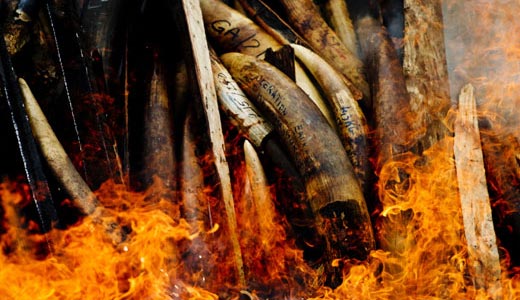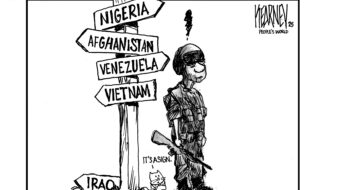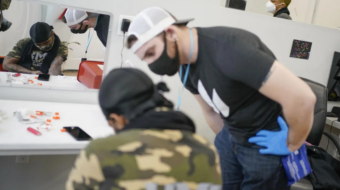
On November 8 in Washington, Secretary of State Hillary Clinton called for a comprehensive, global strategy to combat illegal animal trafficking and poaching. Speaking at the Partnership Meeting on Wildlife Trafficking at the U.S. Department of State, which was attended by conservation groups and representatives of several countries, she underscored the need to address this worldwide problem immediately.
The beginnings of what could become a serious conservation initiative began in a surprising fashion last Thursday, when U.S. intelligence organizations (including the CIA and the NSA) were issued a charge by President Obama and Clinton to track poachers in Africa and Asia, whose smuggling networks are being considered a potential threat to national security. Clinton’s remarks in Washington focused on the next logical step in targeting animal trafficking.
“I’m calling for the creation of a global system of regional wildlife enforcement networks to take advantage of those networks that are already operating, and the lessons we have learned from them,” she said. “The sooner we get this off the ground, the better. And to that end, the State Department is pledging $100,000 to help get this new global system up and running.
“Everyone contributes to the continued demand for illegal animal goods. Wildlife might be targeted and killed across Asia and Africa, but their fur, tusks, bones, and horns are sold all over the world. Smuggled goods from poached animals find their way to Europe, China, Australia, and the United States. I regret to say that the United States is the second-largest destination market for illegally trafficked wildlife in the world. And that is something we are going to adddress.”
Clinton added that she and Obama plan to discuss the matter further at the Association of South-East Asian Nations summit in Phnom Penh, Cambodia next week. One key aspect of the problem is the increasingly sophisticated gadgetry and modus operandi of armed trafficking gangs.
“It is one thing to be worried about the traditional poachers who come in and kill and take a few animals, a few horns, a few tusks, or other animal parts,” Clinton explained. “It’s something else when you’ve got helicopters, night vision goggles, and automatic weapons, which pose a threat to human life, as well as wildlife.”
Crawford Allan, the North American director of wildlife trade monitoring network TRAFFIC, remarked, “The unprecedented surge in wildlife crime reflects a fundamental shift in the structure and operation of the illegal wildlife trade over the past decade.”
Groups such as “TRAFFIC, World Wildlife Fund, and WildAid can’t tackle such threats alone,” Allan concluded. “We need governments to get involved.”
Cristian Samper, president of the Wildlife Conservation Society, said, “Illegal trade in wildlife, timber, and fisheries is estimated to be fueling illicit economies around the world at approximately $10-15 billion, annually.
“This year alone, 30,000 African elephants will be killed for their ivory; it is estimated that 448 rhinos were poached last year in South Africa alone; only 3,200 tigers remain in the wild. And more than 25 million sharks are killed each year, more than one third are either endangered or threatened, and in the case of hammerhead sharks, their population has declined by more than 90 percent since 1970.
“All these species are declining because they are being hunted for the international wildlife trade. The revenues generated by the sale of wild animals support local insurgencies and terrorist activities, and promote political instability.”
It is worth noting that previous presidential administrations have not made such strong moves to crack down on wildlife trafficking. But for President Obama, who has family ties in Kenya – a nation hit particularly hard by poaching – the issue may hit rather close to home.
The criminal network has been a particular cause of grief for Kenyan ranchers, who generally have to triple the number of rangers working on their reserves in order to spare the life of just one rhinoceros, which could be killed for its horns. The costs per month to take the necessary precautions to keep that animal alive often rack up to about $1,200. Demands for rhino horns as ‘miracle drugs’ – despite having no actual medicinal value – continue to rise. It should, therefore, come as no surprise that the world rhino population is on the verge of being completely wiped out.
The issue, Clinton acknowledged, was that conservation groups “cannot solve this problem alone. None of us can. This is a global challenge that spans continents and crosses oceans, and we need to address it with partnerships that are as robust and far-reaching as the criminal networks we seek to dismantle.
“Therefore, we need governments, civil society, businesses, scientists, and activists to come together to edcuate people about the harms of wildlife trafficking. We need the law enforcement personnel to prevent poachers from preying on wildlife. We need trade experts to track the movement of goods and help enforce existing trade laws. We need finance experts to study and help undermine the black markets that deal in wildlife.
“And most importantly, perhaps, we need to reach individuals, to convince them to make the right choices about the goods they purchase.”
Photo: Ivory in Libreville, Gabon, seized from illegal poaching operations, is burned in a ceremony to symbolize a commitment to ending the illegal wildlife trade. James Morgan/World Wildlife Federation & AP










